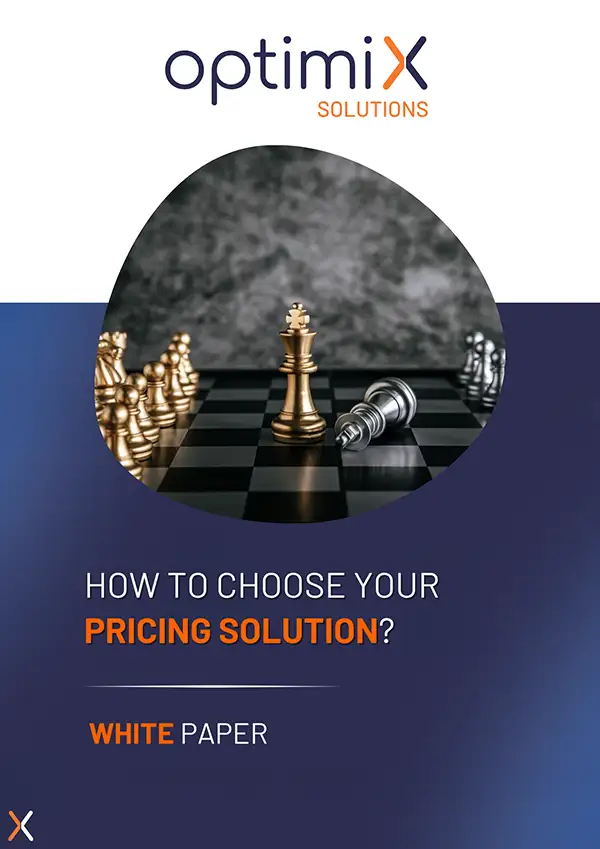Pricing strategy is at the heart of sales performance. In an environment where data is pouring in from all sides, competitors are adjusting their prices in real time, and consumers are comparing before they buy, old-fashioned pricing methods are showing their limits. Excel is no longer enough. Neither is intuition alone. To control your prices, protect your margins and react with agility, you need to rely on pricing tools specially designed to manage your pricing.
Digitizing pricing strategy is not just a matter of comfort: it’s a condition of survival in the face of intensifying competition and increasingly complex decision-making.
In this article, we explore the main tools, software and technologies that today enable you to digitalize and manage your pricing strategy.
Why digitize your pricing strategy?
Today’s companies have to reconcile a number of sometimes contradictory objectives: competitiveness, profitability, price image, responsiveness and personalization. These trade-offs cannot be made effectively without tools. Traditional methods (spreadsheets, manual analyses, isolated processes) are slow and fragile, and don’t allow you to visualize your pricing strategies.
Digitizing pricing means greater precision, speed and collaboration. It also means integrating multiple data (sales, stock, competition, seasonality, promotions) to make better decisions faster, on a larger scale. To find out which of the various pricing strategies to choose, we invite you to read our dedicated article : the different pricing strategies
Overview of pricing tools and their uses
Competitive intelligence and price comparison tools
These pricing tools make it possible to monitor competitors’ prices in real time. They are based on automated collection (scraping, API) and product recognition (matching) technologies. They are essential for positioning your prices in the right market range.
They are used for :
- Monitor and collect competitor prices
- Identify unjustified price differences
- Keeping track of the competition
- Fueling a pricing alignment policy
Pricing software
These pricing solutions are used to build solid, coherent pricing grids, taking into account margin objectives, positioning and internal rules (consistency between ranges, formats, regions, etc.).
They can be used to model price levels according to different axes (customer, channel, segment) and to steer overall pricing policy.
Dynamic pricing tools
Here, prices can be adjusted automatically according to internal data (stocks, margin thresholds, season) and external data (competitor prices, events). These tools often incorporate AI and machine learning algorithms.
They enable :
- Continuously optimize profitability
- React quickly to an opportunity or threat
- Test and adjust in near real time
AI and Machine Learning: the future of strategic pricing
The market is changing fast. Relying solely on traditional pricing methods is no longer sufficient. To think that simple cost analyses, static market studies or competitor comparisons will suffice is to ignore the growing complexity of consumer behavior and market volatility.
This is whereArtificial Intelligence (AI) and Machine Learning (ML) come in, bringing an entirely new and indispensable dimension to pricing strategy. They are transforming the way companies approach pricing, moving from a reactive and often imprecise approach to proactive, optimized price management.
Why have AI and machine learning become indispensable?
- Analysis of massive and complex data: AI and ML excel where humans reach their limits. They can process colossal volumes of data, far beyond what a team could analyze manually. This data comes from a wide variety of sources: your sales history, your competitors’ real-time prices, your customers’ browsing behavior on your website, external factors such as the weather or specific events, and much more. This ability to digest and interpret such heterogeneous information is crucial for a complete view of the market.
- Detecting hidden patterns: ML algorithms don’t just analyze; they uncover trends and correlations invisible to the naked eye. They can identify complex relationships between variables that influence purchasing decisions, such as the price sensitivity of different customer segments, triggers for high demand, or inflection points where a price becomes too high or too attractive. These “hidden patterns” are goldmines for fine-tuning your strategy.
- Prediction and anticipation: thanks to continuous learning from past data, AI becomes a true forecasting tool. It can predict future demand for a given product with great accuracy, estimate price elasticity (i.e. how demand reacts to a price change) for different segments of your customer base, and anticipate reactions to various price changes. This predictive capability enables companies to be proactive and make informed decisions even before the market moves.
- Real-time optimization (Dynamic Pricing): This is undoubtedly one of the major revolutions. Dynamic pricing, made possible by AI, enablesinstant price adjustments. Imagine being able to modify your prices according to live demand, your inventory levels, the prices posted by your competitors, or even the time of day or day of the week. This flexibility maximizes revenue by selling at the right price, at the right time.
- Simulation and prediction platforms: AI and ML are not limited to analysis and adjustment. They power sophisticated simulation platforms. These tools enable you to:
- Test hypotheses: What would happen if I raised the price by 5%? What if I proposed a new pricing structure? AI-based simulations give you precise estimates of the impact on sales, margins and buying behavior.
- Manage promotions: Determine which promotions will be most effective, when and for which products, by forecasting their real impact on your objectives.
- Arbitrate between different pricing options: Instead of guessing, you can objectively compare the potential results of different pricing strategies, and choose the one that maximizes your business objectives.
Integration with BI, ERP and CRM systems
Pricing can no longer be isolated: it must be connected to the company’s data and management systems. Integration makes data more reliable, ensures consistency between departments, and accelerates action.
Key features of a good pricing tool
- Centralized data (sales, competition, ranges, promotions)
- A customizable rules engine
- Data collection
- Linking your products
- Product matching
- Real-time dashboards
- Intelligent alerts
- Simulation capabilities
- An intuitive, collaborative interface
- API connectors for existing systems
How does XPA Optimix Pricing Analytics help retailers with their pricing strategy?
A pricing platform like Optimix Pricing Analytics enables you to effectively manage your pricing strategy by combining artificial intelligence, data collection and control of key indicators. Here are some of its key features:
- Data collection
- Alignment based on configurable rules, variation thresholds and prioritization by channel or range.
- Real-time visualization of your strategies: margins, volumes and price indexes
- Dynamic scenarios to simulate the effect of a price adjustment or promotional campaign.
- Collaborative workflows to involve different departments (offer, marketing, sales) in pricing decisions.
Companies that have chosen our pricing solution are seeing tangible benefits:
- Up to +3 to 5 margin points on product categories
- Better competitive reactivity, thanks to monitoring and alerts
- A significant increase in pricing team productivity
The platform thus becomes a true pricing control center.









